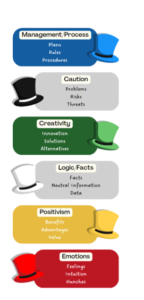Last week, I taught our last webinar, Innovation and The Six Thinking Hats for the Ascend: The Executive Leadership ExperienceSM program. Our students for 46 weeks have been dedicated every week to learn new leadership techniques, strengthening their leadership skills, and practicing these skills in the work that they do every day.
As our students finalize their case studies to present in a couple of weeks, this last webinar teaches them a new way of thinking about innovation and strategies for implementing their case studies after the course is complete.
What is it?

The Six Thinking Hats is a problem-solving technique developed by Edward de Bono that encourages individuals to think about a problem from six different perspectives or modes of thinking. Each mode of thinking is represented by a different colored hat, and each hat represents a unique approach to problem-solving.
The six hats are:
- Blue Hat: represents control and organization. This mode of thinking is meta-cognitive and seeks to manage the thinking process, set goals, and direct the discussion.

- Black Hat: represents caution and critical thinking. This mode of thinking is skeptical and analytical, and it seeks to identify potential problems or pitfalls associated with the proposed solution.
- Green Hat: represents creativity and innovation. This mode of thinking is imaginative and seeks to generate new ideas and possibilities.
- White Hat: focuses on data and information. This mode of thinking is analytical and fact-based, and it seeks to uncover information that is relevant to the problem at hand.
- Yellow Hat: represents optimism and positivity. This mode of thinking is constructive and seeks to identify the potential benefits and advantages of the proposed solution.
- Red Hat: represents emotions and feelings. This mode of thinking is intuitive and subjective, and it allows individuals to explore their gut reactions and emotions in response to the problem.
What makes it unique?
The Six Thinking Hats approach is unique because it provides a structured framework for exploring and analyzing complex problems or situations from multiple perspectives. Here are some key aspects that make this approach stand out:
- Structured Thinking Process: The Six Thinking Hats method provides a clear structure for thinking about a problem, breaking it down into six distinct modes of thinking. This structure helps individuals and teams to approach problems in a systematic and organized manner, preventing chaos and ensuring that all relevant aspects are considered.
- Parallel Thinking: Unlike traditional brainstorming or problem-solving methods where participants may argue or compete for attention, the Six Thinking Hats method encourages parallel thinking. Each participant adopts the same mode of thinking at the same time, focusing on a specific aspect of the problem. This reduces conflicts and allows for a more collaborative and productive discussion.
- Holistic Perspective: By considering the problem from six different angles represented by the six colored hats, the method encourages a holistic perspective. This helps to uncover hidden opportunities, identify potential risks, and generate innovative solutions that may not have been apparent from a single viewpoint.
- Emphasis on Creativity and Critical Thinking: The Six Thinking Hats method balances creativity with critical thinking. It allows participants to explore new ideas and possibilities (Green Hat) while also evaluating them rigorously for feasibility and potential drawbacks (Black Hat). This ensures that solutions are not only innovative but also practical and effective.
- Promotion of Constructive Communication: Each hat has a specific focus, such as data analysis (White Hat), emotional reactions (Red Hat), or optimism (Yellow Hat). This encourages participants to express their thoughts and opinions constructively within a defined context, leading to more effective communication and decision-making.
- Versatility: The Six Thinking Hats method is versatile and can be applied to a wide range of situations, from problem-solving and decision-making to creative brainstorming and strategic planning. It is equally useful for individuals working alone as well as for teams collaborating on complex projects.
A Real World Example
A real-world application of using the Six Thinking Hats in a corporate team setting could be during a brainstorming session for a new product or marketing strategy. Here are a couple of things to keep in mind:
- Typically, one person is a designated facilitator or team leader who would oversee the discussion, ensuring that the thinking process stays on track and that all perspectives are considered. They would guide the team towards making decisions based on the insights gained from each hat.
- You can order the hats in any order you like. Think about your audience, the topic, any obstacles you anticipate, and the overall goal.
- You do not need to include every color hat. I have even had meetings where we only use two different hats, we start with Blue, followed by Green, and then finish with Blue.
Here’s how it might work:
- Blue Hat: I always start with the blue hat to identify the overall process, and in which order we will metaphorically wear each hat, the purpose, expectations, and outcome of the session. This sets the tone for the session and makes sure everyone understands how the session will work.
- White Hat: The team members could start by gathering data and information about the market, competitors, and target audience. They would focus on facts and figures to understand the current situation and identify any gaps or opportunities.
- Red Hat: Next, team members would express their emotions and intuition regarding the project. They might share their gut feelings, concerns, or excitement about potential ideas. This allows for open and honest communication about individual reactions to the proposed strategies.
- Black Hat: Team members would then analyze the potential risks and drawbacks associated with each idea. They would critically evaluate the feasibility of the proposed strategies, considering factors such as cost, time, and potential obstacles.
- Yellow Hat: Following the critical analysis, team members would shift their focus to the positive aspects of each idea. They would identify the potential benefits and advantages, such as increased market share, customer satisfaction, or brand visibility.
- Green Hat: In this phase, team members would engage in creative thinking to generate new ideas or solutions. They would explore unconventional approaches and think outside the box to address any challenges or limitations identified earlier.
- Blue Hat: Finally, I like to end with this hat as well. This is the hat that summarizes the overall process and the next steps.
Overall, the unique combination of structured thinking, parallel exploration of multiple perspectives, and emphasis on both creativity and critical analysis makes the Six Thinking Hats approach a powerful tool for problem-solving and decision-making in various contexts.
Have you used the Six Thinking Hats? Share your experience.
As an Amazon Associate, I earn commission from qualifying purchases linked in this blog.

